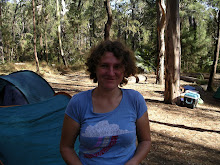Digital Storytelling transforms stories and ideas into a digital medium using images, sounds and voices. You can use still pictures, animation or video clips in a number of easy to use computer programs. I have played with Photo story 3 for Windows for the first time today and found it easy to use. There are some helpful tutorials and resources on line to help you and your students get to grips with it.
Here are some ideas I got from the Message Stick “Voices from the Cape” on ABC about digital storytelling as an authentic and engaging learning experience. A group of specialists went to Aurukun on the Cape to try and engage the students and reduce their poor attendance to school. I am teaching Year 2 and found the introduction used to teach the structure of a digital story to be simple and effective. The teacher wanted something that a student had. He put a chair and another student between him and the student holding the thing he wanted. The beginning - he started to go for the thing he wanted, the middle - he had to work around the obstacles and solve the problems to get through and the end - he got what he wanted. The students were engaged by the movement and the fact that it was funny watching the teacher bump into a chair and give $20 to the student in his way. They learnt a story has a beginning, middle where you come through obstacles and an end.
It was essential to create a safe atmosphere for the students to work in and they were given control to create the stories at their own pace. The outcome was authentic as the films produced were for a local film festival. Digital storytelling is an excellent tool to use in the relate-create-donate Kearsley and Shneiderman (1999) Engagement Theory. My inspired idea using digital storytelling with theis this:
Relate:
The task that needs a solution in my Year 2 class is multiplication.
Create:
In groups the students set up and take photos of different ways to show you how to multiply numbers. One group may take pictures of plates with apples on to show 2 x 3 for example. You can import PowerPoint slides into Photo Story 3 easily to build the story around the photographs. Now the students are looking at the process of multiplication rather than just the answers. The same could be done with addition and number facts.
Donate:
The resulting digital stories will be used for revision and to teach other children.
Really there are endless ideas and stories to tell. I like the idea of students presenting their work for peer review. This could be done on a star rating or comments on the positive and negative aspects with suggestions on possible improvements. For the students to then reflect on the reviews and then comment on any changes they might make is an excellent learning tool for creative and deeper thinking processes.
I look forward to trying this out with mu students.
Subscribe to:
Post Comments (Atom)

What an exciting exploration of digital storytelling! It’s amazing how technology has opened up new ways for people to share stories, whether through videos, blogs, or social media. Digital storytelling blends creativity with modern tools, offering endless possibilities for expression. If you're interested in honing your storytelling skills, creative write course can be a great way to strengthen your writing foundation, which can then be applied to digital formats. Whether it’s crafting engaging narratives or developing strong characters, these courses can help you master the art of storytelling in any medium. Thanks for sharing such an inspiring post!
ReplyDelete